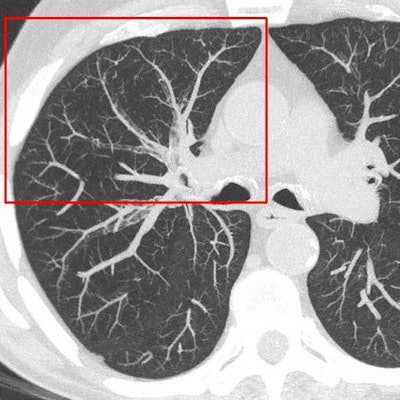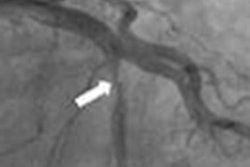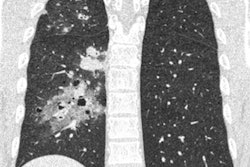
A new ultrahigh-resolution CT scanner -- boasting two times the spatial resolution of conventional CT -- significantly enhanced the image quality of in-stent restenosis in blood vessel phantoms without altering radiation dose, according to an article published online June 26 in Radiology.
The researchers from Osaka University in Japan tested the ultrahigh-resolution CT scanner (Aquilion Precision, Canon Medical Systems) on renal blood vessel phantoms in one of the first published studies using the scanner since it debuted at RSNA 2017. They found that the new machine was capable of producing CT scans with considerably higher spatial resolution and better overall image quality than conventional CT scans -- leading to fewer errors and slightly improved diagnostic accuracy for assessing in-stent restenosis (Radiology, June 26, 2018).
"Overall image quality at [ultrahigh-resolution] CT was significantly superior to that at conventional CT because of the high spatial resolution and the reduction in metal artifacts from stents," wrote first author Dr. Hiromitsu Onishi, PhD, and colleagues.
Higher spatial resolution
Since Aquilion Precision received clearance from the U.S. Food and Drug Administration (FDA) for clinical use this past April, Onishi and colleagues have been assessing the technology's viability within various clinical settings using CT phantoms.
The ultrahigh-resolution CT scanner features a much smaller focal spot size, half the slice width, and double the detector cell density of conventional CT scanners -- all of which enable notably higher spatial resolution. All told, these changes allow Precision to provide 150-micron pixel size and a resolution of up to 50 line pairs per cm (lp/cm) -- compared with the 300 microns and 20 to 24 lp/cm typical for CT scanners of the past decade -- and a pixel matrix that is two times larger than the norm (1024 x 1024 versus 512 x 512).
For the current study, which was sponsored by Canon, the researchers compared the ultrahigh-resolution CT scanner with a conventional CT scanner (Aquilion One, Canon) for evaluating in-stent restenosis in 36 kidney blood vessel phantoms. They additionally applied a hybrid iterative reconstruction algorithm (adaptive iterative dose reduction [AIDR] 3D, Canon) to the images for noise reduction.
Two radiologists reviewed the CT scans and determined overall image quality based on a four-point scale ranging from poor (1) to excellent (4). Their evaluation factored in spatial resolution, the presence of artifacts, and image noise. They used a modulation transfer function technique to quantitatively assess the spatial resolution.
Superior image quality
When analyzing the results, the investigators found that the ultrahigh-resolution CT scans had twice the spatial resolution of the conventional CT scans and considerably superior overall image quality, despite increases in image noise.
| Ultrahigh-resolution vs. conventional CT for assessing in-stent restenosis | ||
| Conventional CT | Ultrahigh-resolution CT | |
| Spatial resolution at 10% modulation transfer function | 12.5 lp/cm | 24.3 lp/cm |
| Spatial resolution at 2% modulation transfer function | 14.3 lp/cm | 29.1 lp/cm |
| Overall image quality* | 2 | 3 |
| Mean error rate of vessel diameter measurements* | 16.9% | 8% |
| Diagnostic accuracy from 2 readings | 72%; 94% | 81%; 97% |
What's more, ultrahigh-resolution CT allowed the radiologists to measure the narrowed segments within the blood vessel phantoms with fewer errors compared with conventional CT (p < 0.001). The newer scanner was also associated with a moderately higher accuracy for the detection of stenosis.
Potential pitfalls?
These marked advantages of ultrahigh-resolution CT bring along with them several concerns, however, including a potential increase in radiation dose, Jia Wang, PhD, and Dr. Dominik Fleischmann from Stanford University wrote in an accompanying editorial.
"With the advances in improving CT spatial resolution, questions arise: Which is the weakest link in the whole imaging chain? What cost in terms of radiation dose efficiency and scanning speed does one need to pay for further enhancing spatial resolution?" they wrote.
To avoid the risks associated with elevated radiation exposure, Onishi and colleagues settled on maintaining the same radiation dose as conventional CT and allowing the image noise to increase instead. They applied an iterative reconstruction algorithm to the CT scans that limited the increase in image noise to only 2.5 times that of conventional CT (as opposed to 16 times without the algorithm).
Other researchers, including Pourmorteza et al, have attempted to address this concern by developing a photon-counting CT scanner capable of enhancing resolution without sacrificing efficiency in radiation dose, although this prototype scanner is not yet available for clinical use.
Promising technical breakthrough
Another issue with integrating the ultrahigh-resolution CT scanner into a clinical scenario is the challenge of viewing and managing a different type of image file, Wang and Fleischmann noted. Clinicians have grown accustomed to reviewing CT scans in a certain way, and adjusting to the considerably higher spatial resolution of extremely high-resolution CT scans will take time.
"Radiologists may need to adapt to the different appearance of the larger image matrix," they wrote. "Support from information technology staff is also essential to reliably transfer, process, display, and store these larger images."
Furthermore, dealing with the massive file size of these scans might not necessarily be worth the cost required to implement them into day-to-day practice, but continued investigation into the clinical value of ultrahigh-resolution CT could eventually help justify the technology's value.
"This [ultrahigh-resolution] CT scanner is a promising technical breakthrough, and it may open doors to more clinical applications that can benefit from enhanced spatial resolution," they wrote. "The trade-off between the clinical benefits of enhanced spatial resolution and the associated costs should be carefully evaluated."
Study disclosures
The study was supported by Canon Medical Systems.




















